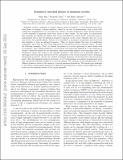| dc.contributor.author | Bao, Yimu | |
| dc.contributor.author | Choi, Soonwon | |
| dc.contributor.author | Altman, Ehud | |
| dc.date.accessioned | 2022-04-01T15:12:55Z | |
| dc.date.available | 2022-04-01T15:12:55Z | |
| dc.date.issued | 2021 | |
| dc.identifier.uri | https://hdl.handle.net/1721.1/141457 | |
| dc.description.abstract | Quantum circuits consisting of random unitary gates and subject to local
measurements have been shown to undergo a phase transition, tuned by the rate
of measurement, from a state with volume-law entanglement to an area-law state.
From a broader perspective, these circuits generate a novel ensemble of quantum
many-body states at their output. In this paper, we characterize this ensemble
and classify the phases that can be established as steady states. Symmetry
plays a nonstandard role in that the physical symmetry imposed on the circuit
elements does not on its own dictate the possible phases. Instead, it is
extended by dynamical symmetries associated with this ensemble to form an
enlarged symmetry. Thus, we predict phases that have no equilibrium counterpart
and could not have been supported by the physical circuit symmetry alone. We
give the following examples. First, we classify the phases of a circuit
operating on qubit chains with $\mathbb{Z}_2$ symmetry. One striking
prediction, corroborated with numerical simulation, is the existence of
distinct volume-law phases in one dimension, which nonetheless support true
long-range order. We furthermore argue that owing to the enlarged symmetry,
this system can in principle support a topological area-law phase, protected by
the combination of the circuit symmetry and a dynamical permutation symmetry.
Second, we consider a Gaussian fermionic circuit that only conserves fermion
parity. Here the enlarged symmetry gives rise to a $U(1)$ critical phase at
moderate measurement rates and a Kosterlitz-Thouless transition to area-law
phases. We comment on the interpretation of the different phases in terms of
the capacity to encode quantum information. We discuss close analogies to the
theory of spin glasses pioneered by Edwards and Anderson as well as crucial
differences that stem from the quantum nature of the circuit ensemble. | en_US |
| dc.language.iso | en | |
| dc.publisher | Elsevier BV | en_US |
| dc.relation.isversionof | 10.1016/J.AOP.2021.168618 | en_US |
| dc.rights | Creative Commons Attribution-NonCommercial-NoDerivs License | en_US |
| dc.rights.uri | http://creativecommons.org/licenses/by-nc-nd/4.0/ | en_US |
| dc.source | arXiv | en_US |
| dc.title | Symmetry enriched phases of quantum circuits | en_US |
| dc.type | Article | en_US |
| dc.identifier.citation | Bao, Yimu, Choi, Soonwon and Altman, Ehud. 2021. "Symmetry enriched phases of quantum circuits." Annals of Physics, 435. | |
| dc.contributor.department | Massachusetts Institute of Technology. Department of Physics | |
| dc.relation.journal | Annals of Physics | en_US |
| dc.eprint.version | Author's final manuscript | en_US |
| dc.type.uri | http://purl.org/eprint/type/JournalArticle | en_US |
| eprint.status | http://purl.org/eprint/status/PeerReviewed | en_US |
| dc.date.updated | 2022-04-01T15:00:49Z | |
| dspace.orderedauthors | Bao, Y; Choi, S; Altman, E | en_US |
| dspace.date.submission | 2022-04-01T15:00:50Z | |
| mit.journal.volume | 435 | en_US |
| mit.license | PUBLISHER_CC | |
| mit.metadata.status | Authority Work and Publication Information Needed | en_US |
